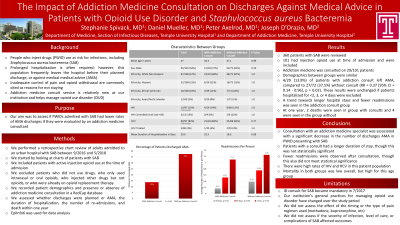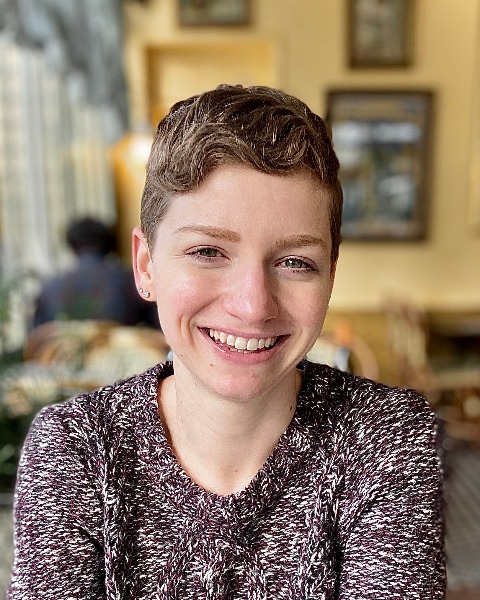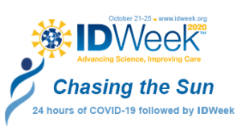Category: Bacteremia
Poster Session: Bacteremia
309 - The Impact of Addiction Medicine Consultation on Discharges Against Medical Advice in Patients with Opioid Use Disorder and Staphylococcus Aureus Bacteremia


Stephanie Spivack
Fellow
Temple University Hospital
Philadelphia, PennsylvaniaDisclosure: I do not have any relevant financial / non-financial relationships with any proprietary interests.
- DM
Daniel Mueller
Assistant Professor, Medicine
Temple University Hospital
Philadelphia, PADisclosure: I do not have any relevant financial / non-financial relationships with any proprietary interests.
- PA
Peter Axelrod
Professor of Medicine
Temple University School of Medicine
Philadelphia, PennsylvaniaDisclosure: I do not have any relevant financial / non-financial relationships with any proprietary interests.
- JD
Joseph D'Orazio
Assistant Professor
Temple University Hospital
Philadelphia, PennsylvaniaDisclosure: I do not have any relevant financial / non-financial relationships with any proprietary interests.
Presenting Author(s)
Co-Author(s)
Background:
People who inject drugs (PWID) are at risk for infectious complications of their injection practices, including Staphylococcus aureus (SA) bacteremia. Prolonged hospitalization is sometimes required; however, rates of discharges against medical advice (AMA) are elevated in this patient population. Inadequate control of pain and opioid withdrawal are commonly cited. Our aim was to assess the effectiveness of addiction medicine consultation for preventing AMA discharges.
Methods:
We performed a retrospective chart review of adult PWID admitted to an urban hospital with SA bacteremia between August 2016 and May 2018. Demographics, HIV and HCV status, and presence or absence of addiction medicine consultation were recorded. We assessed whether discharges were planned or AMA; the number of hospitalizations at 30 days, 90 days, and 1 year from index admission; and death within one year. EpiInfo6 was used for data analysis.
Results:
A total of 360 patients with SA bacteremia were reviewed. Of these, 101 reported intravenous opioid use at admission. Average age was 37 years, and 64% were male. HIV and HCV were present in 13% and 82% of patients, respectively. Addiction medicine was consulted on 29 patients. Of these, 4/29 (13.8%) left AMA, compared to 27/72 (37.5%) of patients without an addiction consult (RR = 0.3678 [95% CI = 0.1412 - 0.9583], p = 0.02).
Patients receiving addiction medicine consultation averaged 0.17 readmissions within 30 days of their index admission, compared to 0.39 readmissions in the group without addiction medicine consult (p = 0.27). Readmissions at 90 days and 1 year were also lower but not statistically significant. At 1 year, 6 deaths were observed; 2 who had addiction medicine consultation and 4 who did not.
Conclusion: Consultation with an addiction medicine specialist significantly reduced the number of patients discharged AMA in a high-risk cohort of PWID presenting with SA bacteremia. Numerically fewer readmissions occurred after consultation, though this difference was not statistically significant. Mortality in both groups was low. There were high rates of HIV and HCV in this patient population, suggesting a particularly vulnerable patient population, which warrants further study.

